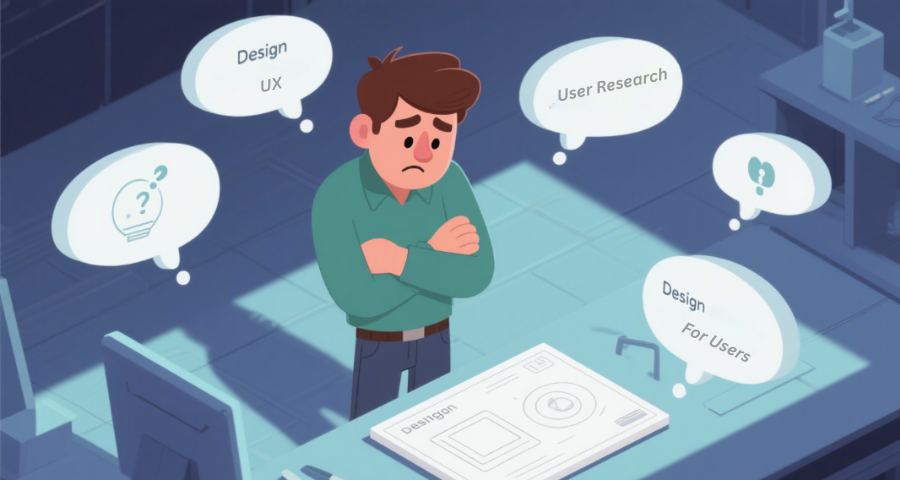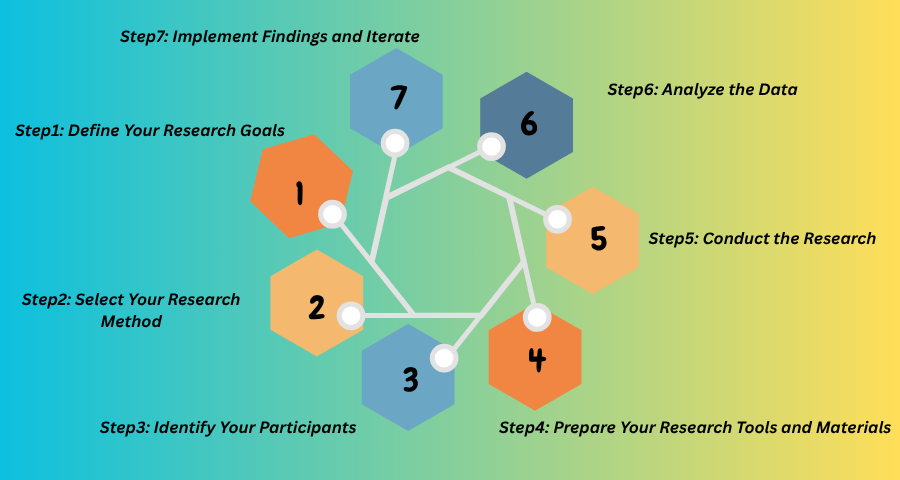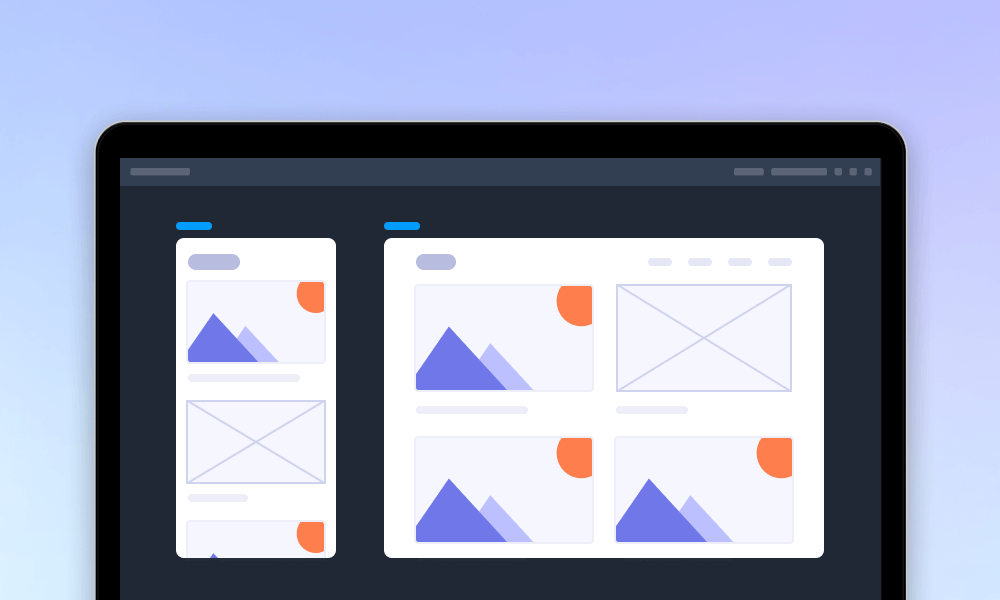User research is the cornerstone of creating successful and user-centered designs in the world of UX. It allows designers to gather valuable insights about user needs, preferences, and pain points, ensuring that the final product aligns with user expectations. Without thorough user research, designs can miss the mark, leading to poor user experience and costly design iterations.
In this guide, we’ll walk you through the essential aspects of user research in UX design, explaining why it matters, how to conduct it effectively, and the different methods you can use. Whether you're just getting started or looking to refine your process, this comprehensive user research guide will provide you with the tools and knowledge to design products that resonate with your users.
While improving your website or app UX, also try our
free ux design tool to quickly visualize and test out your UX design ideas.
What is User Research in UX Design?
User research in UX design refers to the process of gathering insights into users' needs, behaviors, and motivations to inform design decisions. It involves directly engaging with users or observing how they interact with products or services. The goal is to understand users deeply, ensuring that the designs created meet their true needs and solve their real problems.
The purpose of user research is to uncover vital information that can drive the design process. By understanding user goals, pain points, and preferences, designers can create user-centered products.
SourceWhy User Research Matters?
User research plays a critical role in the UX design process, ensuring that the final product is intuitive, user-friendly, and relevant to the target audience. Below are some of the key reasons why user research is so important:
Improve UX Design
User research helps designers understand how users interact with products, ensuring the final design is intuitive and user-friendly.
Reduces Risks
User research helps minimize the risk of designing a product that doesn’t resonate with its intended audience. By identifying users' needs, pain points, and preferences early on, you reduce the chance of making costly mistakes during development or after the product launch. Gathering real user feedback ensures you are always on the right track.
Informs Decision-Making
One of the greatest benefits of user research is that it provides data-driven insights to guide design decisions. Rather than relying on assumptions or intuition, designers can make decisions backed by actual user feedback, ensuring that each design change is meaningful and impactful.
Saves Time and Money
Conducting user research early in the design process can save time and resources by identifying potential problems before development begins. Early-stage insights help avoid the need for major revisions down the line, leading to a more efficient design process and a product that is ready for users faster.
Foster Innovation
Engaging with users not only helps identify pain points but also uncovers new opportunities for innovation. By understanding users' challenges, designers can create solutions that surprise and delight, offering features and experiences that users truly value and that set your product apart in the market.
By integrating user research into the design process, you not only ensure that your product meets the needs and expectations of its users, but also create a more effective, innovative, and user-friendly experience.
With these insights, you are equipped to make informed design decisions that will truly resonate with your target audience. In the next section, we’ll dive into the key differences between user research, user testing, and UX research, to better understand when and how to apply each method in the design process.
User research vs User testing vs UX research
Many people often confuse user research, user testing, and UX research, thinking that they are interchangeable terms. While they are all closely related and essential to the UX design process, they each serve distinct purposes and are used at different stages of product development. Let’s take a closer look at the definitions of each and explore their differences.
User Research: Refers to the process of gathering broad insights about users' behaviors, needs, and motivations through various methods like interviews, surveys, and focus groups. The aim is to understand users and their problems, helping designers build products that are aligned with real user needs.
User Testing: Focuses on evaluating the usability of a product or prototype. It involves testing design concepts by observing real users interacting with them. The goal is to identify usability issues, understand how users navigate through an interface, and validate design decisions.
UX Research: A comprehensive approach that includes both user research and user testing, along with other data-gathering techniques such as analytics, heatmaps, and user feedback. UX research aims to understand the full user experience—from the early stages of design to post-launch—and how the product aligns with business goals.
Now that we’ve defined each of these terms, let's dive into how they differ in terms of purpose, methods, and when to use them.
Purpose
User Research: The primary goal of user research is to understand users' needs, behaviors, and motivations. This is typically done early in the design process to gather insights that inform the product strategy. User research helps designers avoid assumptions by providing real-world data, ensuring that the design aligns with what users truly want and need.
User Testing: User testing focuses on evaluating a product or prototype’s usability. The goal is to observe how real users interact with a design, identifying pain points and usability issues. This method ensures that the design works in practice and is easy for users to navigate.
UX Research: UX research is an umbrella term that encompasses both user research and user testing, but it also includes a broader set of methods such as market research, analytics, and user feedback to evaluate the overall user experience. Its aim is to understand how users interact with a product, and how well the design meets both user needs and business goals.
When it's Used
User Research: Conducted at the beginning of the design process, typically in the discovery phase, to understand the users' needs, pain points, and motivations. This helps define product goals and sets the design direction.
User Testing: Typically done in the prototyping or final design phase to test usability and functionality.
UX Research: Ongoing throughout the entire design and development cycle, from the initial design phase to post-launch. It helps refine the user experience continuously, ensuring the product evolves based on real user feedback and behaviors.
Methods
User Research: Includes methods like interviews, surveys, focus groups, and ethnographic studies. These qualitative and quantitative techniques help gather broad insights into user motivations and needs.
User Testing: Primarily involves techniques like usability testing, A/B testing, and task analysis. By testing these prototypes with real users, designers can observe behavior in a realistic environment and identify pain points early in the design process.
UX Research: Combines user research and user testing, along with additional methods such as heatmaps, analytics, and user feedback surveys. This comprehensive approach ensures a holistic understanding of the product's performance across various touchpoints.
Outcome
User Research: Provides foundational insights into users’ goals, needs, and challenges, which inform the product’s strategy and design direction. This helps to avoid assumptions and ensure that the product resonates with users.
User Testing: Identifies specific usability issues and helps validate design decisions.
UX Research: Offers a comprehensive view of the overall user experience, from initial interactions to post-launch feedback. It helps refine the product, ensuring that the design not only meets user needs but also aligns with business goals, increasing the likelihood of success in the market.
When to conduct user research in the ux design & development cycle?
User research should be conducted at multiple stages throughout the
UX design and development cycle to ensure the product is built around user needs and behaviors. Here’s when to conduct user research at different phases of the cycle:
Discovery Phase
User research is crucial in the discovery phase of the UX design cycle. This is the stage where you gather foundational insights about your users’ goals, challenges, and behaviors. The information collected during this phase will help define the overall direction of the product.
Conduct user interviews, surveys, and market research to understand user needs and pain points.Develop user personas to represent the target audience.Identify high-level goals and challenges to inform the product strategy.
User research during the discovery phase helps set the product’s vision and ensures you are solving the right problems. Early insights help avoid wasted effort by ensuring the design is aligned with real user needs from the start.
Design Phase
Once you have a clearer understanding of user needs, the next step is to validate design concepts and wireframes. During this phase, user research helps refine design solutions, test assumptions, and optimize user flows before moving to development.
Conduct usability testing on prototypes created using tools like
Mockplus.
Perform card sorting or tree testing to determine how users perceive and navigate the product structure.Collect feedback from users on initial design concepts and wireframes to ensure they align with expectations.
Research at this stage helps fine-tune the design and confirm that your product’s user interface is intuitive.
Development Phase
During the development phase, user research should be focused on validating the functionality and usability of the product before launch. This is the point where prototypes and final products are tested with real users to identify any usability issues.
Conduct usability tests with working prototypes or the product itself.Analyze analytics data and gather feedback from beta testers to identify any pain points or areas that need improvement.Conduct task analysis to see how users perform key actions within the app or website.
Testing with real users in this phase ensures that the final product works as intended. It helps catch any remaining usability issues before launch and gives designers the opportunity to refine features based on actual user behavior.
Post-Launch
User research shouldn’t stop after the product is launched. Post-launch research is essential for continuously improving the product and adapting to evolving user needs.
Collect user feedback through surveys, in-app feedback, and user interviews.Use tools like heatmaps and user recordings to observe how users are interacting with the product after it’s live.Monitor key performance indicators (KPIs) and use A/B testing to optimize specific features or user flows.
Post-launch research helps identify areas for improvement and informs future updates. It also provides insights into user satisfaction, helping you refine the product over time to meet user expectations and improve the overall user experience.
In conclusion, user research should be conducted at every phase of the UX design and development cycle—from discovery and design to development and post-launch. Each stage of research provides critical insights that ensure your product is user-centered and continuously improved based on real user feedback.
Types of user research
User research can be divided into different categories based on the methods and goals of the research. Below are the key types of user research you need to know:
Qualitative research
Qualitative research aims to explore and understand user behaviors, motivations, and pain points in-depth. It focuses on gathering descriptive insights into the "why" behind users' actions and decisions. This type of research is typically used early in the design process to understand users' needs and frustrations before developing design solutions.
User Interviews: Conducting one-on-one conversations to gain deep insights into users' thoughts, feelings, and motivations.
Focus Groups: Group discussions where users share their opinions on a product or concept, providing collective insights into user preferences.
Ethnographic Studies: Observing users in their natural environments to understand how they interact with products or services in real-life settings.
Qualitative research provides deep, human-centered insights, allowing designers to uncover user emotions and attitudes. This understanding is essential for creating user-centered designs that resonate with your audience.
Quantitative research
Quantitative research focuses on collecting numerical data to identify patterns and trends in user behavior. It is used to validate assumptions and measure the impact of design decisions. This type of research helps designers gather objective data that can be used to make data-driven decisions and ensure design solutions are effective at scale.
Surveys: Structured questionnaires that collect responses from a large user group, helping to quantify user preferences, behaviors, and satisfaction.
Analytics: Tools like Google Analytics track and analyze user behavior, such as clicks, time spent on pages, or bounce rates.
A/B Testing: Comparing two design variations to see which one performs better in terms of user engagement or conversion rates.
Heatmaps: Visual representations of user activity on a webpage, showing where users click, scroll, or hover the most.
Quantitative research allows you to gather objective data and measure how users interact with a product. This type of research helps in validating insights from qualitative research and ensures that design decisions are backed by solid, data-driven evidence.
Primary research
Primary research involves collecting new, original data directly from users or participants. This type of research is tailored to your specific project and provides highly relevant, actionable insights into your target audience's needs, behaviors, and preferences.
User Interviews: One-on-one conversations that provide rich, detailed insights into user thoughts and behaviors.
Usability Testing: Observing users as they interact with prototypes or products to identify usability issues and areas for improvement.
Surveys and Polls: Collecting quantitative data from users to assess user satisfaction, preferences, and feedback.
Primary research allows you to collect data that is directly relevant to your product, giving you insights that are specific to your project’s goals. This method ensures that your research findings are highly targeted, leading to more focused design decisions.
Secondary research
Secondary research involves gathering data that has already been collected by other researchers or organizations. It includes industry reports, academic papers, existing market research, and even publicly available user feedback. Secondary research can help designers get a broader perspective on user needs and industry trends, without having to start from scratch.
Literature Reviews: Analyzing existing research papers, articles, or studies to gather secondary data on user behavior, market trends, and best practices.
Competitive Analysis: Examining competitors’ products to understand their strengths, weaknesses, and user engagement strategies.
Market Research Reports: Using industry reports and research from firms like Nielsen or Statista to understand broader market trends and user expectations.
Secondary research allows you to gain valuable context and insights without the need for extensive primary data collection. It helps you build upon existing knowledge, understand market trends, and identify opportunities for your product, all while saving time and resources.
Understanding the different types of user research is crucial to creating effective, user-centered designs. Qualitative research helps uncover deep insights into user motivations, while quantitative research provides objective data to validate assumptions.
Primary research gives you direct, project-specific insights, while secondary research allows you to leverage existing knowledge to inform your design decisions. By combining these approaches, you ensure that your product is both data-driven and emotionally resonant with users.
Common User Research Methods
There are a variety of user research methods that UX designers can use to gather valuable insights from users. These methods allow designers to understand user behaviors, test assumptions, and validate design decisions. Let’s look at some of the most common methods and how they can be applied in the UX design process.
Surveys
Surveys are a popular method for collecting quantitative data from a large group of users. They are commonly used to gather information about user preferences, behaviors, satisfaction, and attitudes toward a product or feature. Surveys can be distributed online or in-person, and the data gathered can be analyzed to identify trends, patterns, and user needs.
Interviews
Interviews are one of the most effective methods for gathering qualitative data. In user interviews, designers engage with users on a one-on-one basis to explore their experiences, pain points, and needs in-depth. These conversations allow designers to dive deep into the emotional and contextual aspects of user behavior, which often cannot be captured through surveys alone.
Focus Groups
Focus groups involve gathering a small group of users to discuss a product or feature. The moderator leads the discussion, asking open-ended questions to uncover collective opinions and insights. Focus groups allow designers to observe group dynamics, discover areas of agreement or disagreement, and get a range of perspectives on a product.
Usability Testing
Usability testing is one of the most common methods used to assess how easy and intuitive a product is to use. In usability testing, real users interact with prototypes or live products, and researchers observe their behavior to identify usability issues. It is often used to test specific features or tasks to understand how users navigate through them.
When to use:
Why it matters: Usability testing helps designers understand how users interact with a product, pinpointing potential pain points, navigation problems, or confusing interface elements. It helps improve the overall usability of a product.
A/B Testing
A/B testing is a controlled experiment where two versions of a webpage or product feature are shown to different user groups. The goal is to compare how different versions perform in terms of user engagement, conversion rates, or other metrics. This method is useful for optimizing specific aspects of a product, such as a call-to-action button or layout design.
Ethnographic Studies
Ethnographic studiesinvolve observing users in their natural environments to understand how they interact with products or services in real-life settings. This method provides deep insights into user behavior, allowing designers to observe not only what users do but also how and why they do it.
Each of these user research methods plays a vital role in gathering insights that inform design decisions and improve user experiences. While methods like surveys and A/B testing are excellent for gathering quantitative data, interviews, focus groups, and usability testing offer qualitative insights that are equally valuable.
By combining these methods, designers can ensure their products are user-centered, intuitive, and aligned with real user needs.
How to Plan & Conduct User Research Step by Step?
Planning and conducting user research is a systematic process that involves several key steps to ensure that the research is efficient, focused, and provides valuable insights. Whether you're conducting qualitative or quantitative research, having a clear plan will help you stay on track and achieve meaningful results. Here’s a step-by-step guide to planning and conducting user research:
Step 1: Define Your Research Goals
Before diving into the research, it’s crucial to define what you want to learn. Clear goals will guide the entire research process and ensure that the data you collect is aligned with your objectives.
What to do:
Identify the specific problem you are trying to solve.
Determine user behaviors, needs, or pain points you want to understand.
Set measurable objectives for your research
Step 2: Select Your Research Methods
Once you’ve defined your goals, decide on the research methods that best suit your objectives. Different methods yield different types of insights, and selecting the right one depends on whether you need qualitative or quantitative data.
What to do:
- For qualitative insights, consider using methods like interviews, focus groups, or ethnographic studies to dive deep into user motivations and behaviors.
- For quantitative data, use methods like surveys, analytics, or A/B testing to gather measurable, statistical insights.
- If testing a prototype or design, consider conducting usability testing using tools like Mockplus, which allows you to quickly create interactive prototypes and gather user feedback.
Step 3: Identify Your Participants
Knowing who your participants are is critical for gathering relevant and accurate insights. The quality of your research depends on selecting the right participants who reflect your target user group.
What to do:
- Define your target audience based on user personas or demographic criteria.
- Select a sample size that will provide enough data to draw meaningful conclusions.
- Ensure diversity in your participant group, especially if you’re conducting usability tests or interviews, to capture a variety of perspectives.
Step 4: Prepare Your Research Tools and Materials
Once you’ve selected your methods and participants, prepare all the materials you’ll need to conduct the research. This includes questionnaires, discussion guides, prototypes, or tools for collecting data.
What to do:
- Create a research plan or discussion guide to keep the research on track.
- Set up tools for data collection, such as surveys or analytics platforms.
Step 5: Conduct the Research
This is the stage where you execute your plan and gather data. Be sure to follow the guidelines you’ve set, whether you’re interviewing users, testing a prototype, or collecting survey responses.
What to do:
- For interviews, conduct one-on-one conversations and take detailed notes or record sessions.
- For usability testing, observe users interacting with prototypes or the product and note usability issues or challenges they face.
- If using surveys or analytics, distribute your surveys or analyze data from tools like Google Analytics or Hotjar.
Step 6: Analyze the Data
Once the research is complete, it’s time to analyze the data and draw actionable insights from it. This stage involves looking for patterns, identifying issues, and synthesizing findings to guide your design decisions.
For qualitative data, categorize feedback into themes or trends.
For quantitative data, analyze survey results, survey metrics, or usage data to identify statistical trends.
Use visual tools to make sense of large datasets and highlight key findings.
Step 7: Implement Findings and Iterate
The final step is using the insights gained from user research to improve the design. Make sure that the findings are implemented into the design process, and iterate on the product or prototype based on user feedback.
What to do:
- Prioritize key issues identified during research (e.g., usability problems or unmet user needs).
- Use insights to refine features, adjust designs, or even pivot the product strategy if necessary.
Conclusion
User research is fundamental to creating products that truly meet user needs. By understanding user behaviors, motivations, and pain points, designers can make informed decisions that improve user experience. T
This guide has covered the key types of user research, methods to apply, and how to plan and conduct research effectively.
From qualitative insights into user emotions to quantitative data that validates design decisions, each research method contributes to creating user-centered products.








 Mockplus RP
Mockplus RP
 Mockplus DT
Mockplus DT
